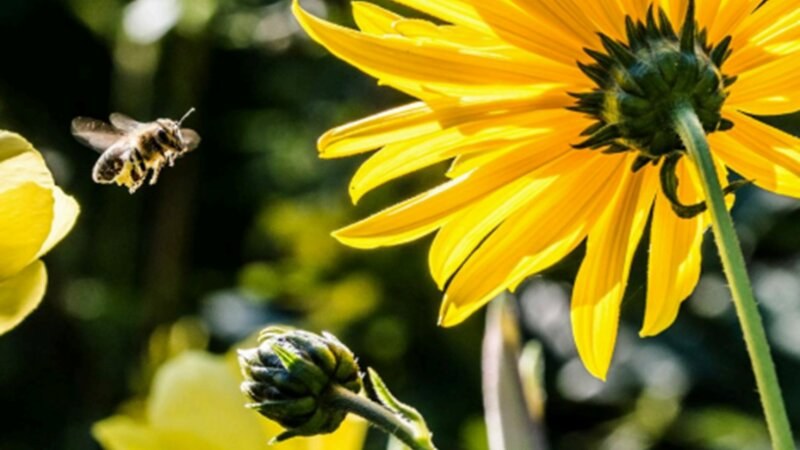Bee Kind: Understanding The Role of Bees in Ecosystems
Reading time: 7 minutesThere are over 40,000 different species of bees worldwide. In Canada alone, there are approximately 1,000 different species, with Alberta, Saskatchewan, and Manitoba home to 67% of Canadian honey bee colonies. But in spite of that, we’ve been seeing a decline in the number of bees worldwide. Experts are calling this Colony Collapse Disorder.
It’s hard to understand why this is happening. Still, we’re seeing that this decline is attributed to various factors such as habitat degradation, pesticide application, climate shifts, and the impact of pests and diseases. And so, we want to renew our commitment to saving the bees. Let’s understand their role in our lives.

Ways Bees are Important to the Environment
They’re The Best Pollinators
Bees are amazing at pollination. Their features, like hairy bodies, make them super efficient at collecting and spreading pollen among flowers. What's remarkable is that they're not picky—they'll visit all kinds of flowers, from crops to wild plants, which helps keep our environment diverse and healthy. Plus, they've got these neat tricks, like buzzing just right to shake pollen loose from certain flowers.
And let's not forget their teamwork!
Some bee species live together in colonies and work together to gather nectar and pollen, making sure everyone is fed and their flowers are well-pollinated. It's incredible how bees have been doing this for ages, playing a crucial role in our ecosystems and food production.
Plant Growth
Bees help wild plants grow and reproduce by moving pollen from one flower to another as they collect nectar and pollen for themselves. This pollen transfer leads to fertilization and seed production, allowing the plants to reproduce and thrive in their natural habitats. In simple terms, bees are like nature's matchmakers for wild plants, ensuring they can keep growing and spreading.
Food Source
The primary food source for bees is nectar, a sugary fluid found in flowers, which they collect for energy. They also make honey, which we harvest. But get this: We’re not the only ones who are fans of that thick, gooey sweetness. Birds, raccoons, opossums, and insects also invade beehives for honey.
In addition, pollinators produce one-third of the US food supply in fruits, vegetables, and nuts and half of the world’s oils, fibres, cotton, and other raw materials. In fact, honeybees contributed an estimated $538 million to the B.C. economy and over $3.2 billion across Canada.
Bees are also an essential part of the food chain and act as a food source for over 24 bird species. If the number of bees continues to dwindle, this could create a chain reaction that could disrupt the food chain.
Fun Fact: Bees are the only insects that make food that humans eat.
Wildlife Habitats
While bees are often celebrated for their intricate hives, they play a crucial role beyond their own colonies. They actively contribute to constructing homes for countless insects and animals—even trees! For example, several tree species, including willows and poplars, heavily rely on pollinators like bees for their reproduction.
Health Products
Honey and other bee products offer a range of health benefits to humans. Honey—a natural sweetener produced by bees—is rich in antioxidants, vitamins, and minerals, making it a nutritious alternative to refined sugar. Its antimicrobial properties can help soothe sore throats and coughs, making it a popular remedy for respiratory infections.
Additionally, honey's anti-inflammatory properties may aid in wound healing and alleviate gastrointestinal issues such as gastritis and ulcers.
Bee pollen—another bee product—is a nutrient-rich substance containing proteins, vitamins, and minerals that can boost immune function and relieve allergies. Propolis, a resinous substance bees use to seal their hives, has antimicrobial and anti-inflammatory properties, making it useful for treating minor skin injuries and infections. Overall, incorporating honey and bee products into your diet can contribute to improved health and well-being.
Where Do Bees Thrive?
Wherever there are flowers, there are bees. Here are some wildlife habitats in which they reside.
Prairies and Grasslands
Canada's vast prairies and grasslands, particularly in provinces like Alberta, Saskatchewan, and Manitoba, provide important habitats for numerous bee species. Bees in these regions often nest in the ground, using the open spaces and abundant wildflowers for foraging.
Boreal Forests
Canada's extensive boreal forests, which span across the country's northern regions, are also home to many bee species. These bees can be found nesting in dead wood or soil or utilizing cavities in trees for nesting sites. Boreal forests offer various flowering plants that provide food sources for bees.
Alpine Meadows
In regions with higher elevations, such as the Rocky Mountains and other mountainous areas, alpine meadows provide great habitats for certain bee species. These bees are adapted to cooler temperatures and often rely on alpine flowers for nectar and pollen.
Wetlands and Riparian Areas
Wetlands, marshes, and riparian zones throughout Canada are also important habitats for bees. Bees in these areas may nest in the ground or vegetation along water bodies.

What Happens If Bees Keep Dying?
Honey bees visit between 50 to 100 flowers during one pollination trip. If bees continue to decline, this means we have less pollination. The result? We’d lose access to a healthy diet. That means less honey, medication, fruits, corn, wheat, and so on.
What Are The Biggest Threats to Bees?
Pesticides
Many pesticides, especially insecticides, can harm bees and their food sources. Either by direct exposure or by contaminating the environment. Pesticides, like neonicotinoids, are a big problem for bees because they mess with their ability to find food and return to their homes.
Air Pollution
Pollution can interfere with the bee's ability to find floral scents and detect food. Water pollution can lower the quality of water sources for bees.
Invasive Species
They threaten bees by competing for resources, predation, altering habitats, transmitting diseases, and disrupting native plant-pollinator relationships.
Actions You Can Take To Help Preserve Bees
Here are a few things you can do to preserve bees:
- Plant a pollinator-friendly garden with native flowers that bloom throughout the seasons. This will provide food and habitat for bees and other pollinators.
- Provide water and shelter for bees by adding a tray or birdbath of water with rocks or marbles in it, and leaving some areas of your yard undisturbed or with natural materials like wood or straw.
- Avoid pesticides or herbicides that can harm bees and their food sources. Choose organic or eco-friendly alternatives whenever possible.
- Support local beekeepers by buying their honey and other products and learning more about their practices and challenges.
- Get involved in your community by joining or starting a bee-friendly initiative, such as a pollinator garden, a citizen science project, or a bee advocacy group.
Buzz Boss: Sustainable Pest Control Solutions for a Balanced Ecosystem
While bees play a crucial role in maintaining ecosystem balance through pollination and contributing to biodiversity, invasive pests like hornets and wasps pose threats to both humans and other pollinators.
At Buzz Boss, we provide top-notch pest control services with a special focus on effectiveness, proactive measures, and eco-friendly solutions that are safe for everyone!
Our BuzzShield® Complete treatment is designed to address potential wasp issues before they become a problem, keeping our fuzzy buddies safe. Get the best wasp and hornet control.
Book us now for bee-friendly and sustainable pest control.

FAQs About Pest Control and Bees
How can I tell the difference between bees, hornets, and wasps?
Bees, hornets, and wasps are all members of the order Hymenoptera, but they have some distinct features that can help you tell them apart. Bees are usually fuzzy and have round bodies, while hornets and wasps are more slender and have a narrow waist.
Bees also have a barbed stinger that stays in the skin after stinging, while hornets and wasps have a smooth stinger that can sting multiple times.
Bees are primarily herbivorous and feed on nectar and pollen, while hornets and wasps are mainly carnivorous and feed on other insects.
Why Should Wasp Pest Control be Proactive?
Proactive pest control is crucial, and Buzz Boss offers monthly treatments to protect your home. With the rising number of wasps in Alberta, Manitoba, Saskatchewan, and British Columbia, our WaspShield service ensures your family's safety by addressing potential issues before they arise.
How can you identify different types of wasps and their nests?
Differentiate wasps by their appearance and behaviour. Yellow jackets have yellow and black stripes, hornets are larger with black bodies and white rings, while paper wasps have slender bodies with yellow and black markings. Yellow jackets are aggressive, hornets sting multiple times, and paper wasps are generally calm.
What should you do if you or your pet gets stung by a wasp?
If a wasp stings you, gently remove the stinger, wash the area with soap, and put a cold pack on it. If you feel pain or have an allergic reaction, consider taking pain relievers or antihistamines. Head to the ER if you have a severe allergic reaction.
If your pet gets stung, speak with a vet, especially if it's in a sensitive spot or if your pet seems uneasy.

